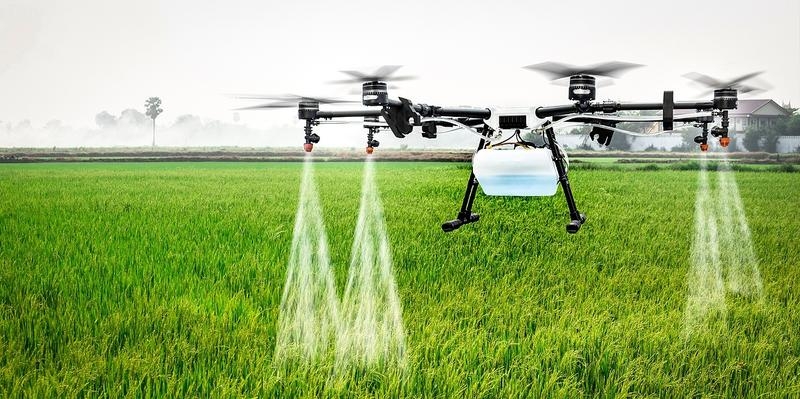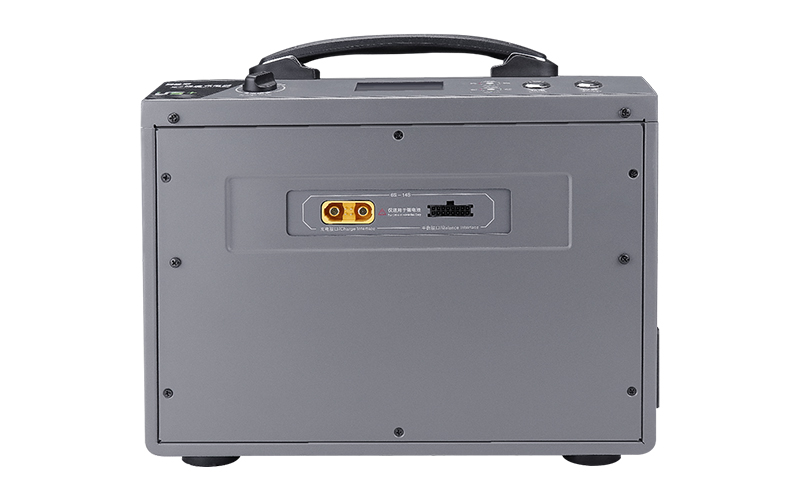Powering Up: The Irrigation Drone Charger
Irrigation drones represent state-of-the-art agricultural instruments that have transformed farmers’ field management practices. These autonomous aerial devices come equipped with advanced technology tailored for precise crop watering, resulting in heightened productivity and the sustainable conservation of water resources.
Within the sphere of irrigation drones, a dedicated irrigation drone charger assumes a pivotal role in guaranteeing the seamless functionality of these advanced agricultural aides. This charger transcends the conventional power source, standing as a sophisticated apparatus meticulously crafted to cater to the distinct requirements of irrigation drone batteries, ultimately optimizing their longevity and operational efficiency.
Comprehending the Irrigation Drone Charging System
Clarification of the Irrigation Drone Charger’s Role
The irrigation drone charging system plays an indispensable role in the functionality of contemporary agricultural irrigation drones. Its primary objective is to furnish a dependable and efficient mechanism for replenishing the drone’s battery reserves. Below is a comprehensive breakdown of its core functions:
1) Power Supply: The charger establishes a connection with a power source, typically through a conventional electrical outlet or alternative power supply methods like generators or solar panels. It converts the electrical energy from the source into a suitable form for recharging the drone’s batteries.
2) Battery Compatibility: The charger is meticulously engineered to harmonize with the specific battery type and voltage utilized in the irrigation drone. This ensures that the batteries receive the precise electrical input essential for safe and efficient recharging.

3) Safety Features: Most irrigation drone chargers come equipped with an array of safety features, encompassing safeguards against overcurrent, overvoltage, and temperature irregularities. These protective attributes serve to prevent battery damage and mitigate the risk of accidents during the charging process.
Adaptability Across Various Irrigation Drone Models
Irrigation drone chargers are typically designed with specific compatibility in mind, tailoring their functionalities to align with particular drone models or brands. The facets of compatibility encompass
1) Battery Variant: Distinct drone models may rely on different battery types, including lithium-polymer (LiPo), lithium-ion (Li-ion), or proprietary battery technologies. The charger must be calibrated to work harmoniously with the battery type specific to the drone in question.
2) Voltage and Capacity Alignment: It is imperative that the charger’s voltage specifications and charging capacity align precisely with the drone’s battery specifications. Mismatches in voltage or capacity could lead to inefficient charging or potential damage to the batteries.
It is incumbent upon drone operators to meticulously verify that the charger they select explicitly aligns with their specific drone model. This diligence safeguards against compatibility hitches and the potential for damage to the drone’s battery system.
Charging Capacity and Speed Considerations
The charging capacity and speed parameters of an irrigation drone charger are contingent on several critical factors:
1) Battery Capacity: The charger’s capacity must be commensurate with the aggregate capacity of the drone’s batteries. For example, if a drone employs multiple batteries with a combined capacity of 10,000 mAh, the charger must have a capacity equal to or greater than this sum to facilitate simultaneous charging.
2) Charging Velocity: Charging speed hinges on the charger’s current output, quantified in amperes (A). Augmented current output leads to accelerated charging, but it must remain within the batteries’ safe charging thresholds to prevent overheating or damage.
3) Multi-Battery Support: In scenarios where irrigation drones employ multiple batteries concurrently for prolonged flight durations, the charger should be equipped to support parallel charging of multiple batteries. This minimizes operational downtime.
It is imperative to strike a judicious balance between expeditious charging and the preservation of battery health. The charging capacity and speed parameters must be tailored to dovetail with the specific requisites of the irrigation drone and the operational demands of the user.
Crucial Aspects of the Irrigation Drone Charger
Portability and User-Friendliness
1) Compact Design: Many irrigation drone chargers sport a compact and lightweight construction, facilitating effortless portability to different field locations.
2) Intuitive Interface: These chargers often boast user-friendly interfaces with straightforward controls, making them accessible even to individuals lacking technical expertise.
3) Swift Setup: They are typically engineered for quick and trouble-free setup, minimizing the time required to deploy the charger in the field.
Safety Measures and Protective Features
1) Overcurrent Safeguard: The charger is equipped with overcurrent protection to prevent excessive current flow, which could harm the batteries or pose safety hazards.
2) Overvoltage Defense: It incorporates safeguards against overvoltage, guaranteeing that the batteries receive the correct voltage to avert damage.
3) Temperature Surveillance: Advanced chargers integrate temperature sensors to monitor battery temperature during charging, thwarting overheating and potential thermal harm.
4) Short Circuit Prevention: Short circuit protection is a critical safety feature, preventing electrical shorts that could damage the charger, batteries, or other components.
Connectivity Options and Integration of Smart Technologies
1) Wireless Connectivity: Certain chargers offer wireless connectivity options, enabling operators to remotely monitor and manage the charging process via smartphones or tablets.
2) App Compatibility: They may seamlessly integrate with specialized apps that furnish real-time data on charging status, battery health, and recommended maintenance.
3) Drone System Integration: Many contemporary chargers are meticulously crafted to seamlessly mesh with the overall drone system, allowing communication with the drone’s flight controller to optimize charging and mission planning.
4) Smart Charging Algorithms: Advanced chargers may employ intelligent algorithms to optimize the charging process, factoring in variables like battery conditions, weather conditions, and mission requirements.
Advantages of Utilizing the Irrigation Drone Charger
Augmented Efficiency in Irrigation Drone Operations
1) Diminished Downtime: Speedy and efficient charging minimizes the intervals between drone missions, enabling more frequent and productive irrigation and monitoring activities.
2) Enhanced Flight Durations: Properly charged batteries empower the drone to cover expansive areas and execute multiple tasks within a single flight, heightening operational efficiency.
Prolonged Drone Lifespan via Prudent Charging
1) Battery Vitality: Charging with precise voltage and current, alongside balancing functions, preserves the health of the drone’s batteries, extending their operational life.
2) Reduced Maintenance Expenses: By safeguarding battery integrity, operators can evade frequent battery replacements, thus curtailing long-term maintenance outlays.
Fiscal Savings and Mitigated Downtime
1) Operational Cost Reduction: The charger’s efficiency and compatibility features curtail operational expenses tied to energy consumption and battery maintenance.
2) Mitigated Repair Expenditures: Safety mechanisms and protective features thwart damage to the drone and its components, consequently diminishing costs related to repairs and replacements.
Promotion of Sustainable Farming Practices and Resource Optimization
1) Resource Efficiency: Efficient drone operations facilitated by the charger permit precise and targeted irrigation, thereby diminishing water and fertilizer consumption and fostering sustainable farming practices.

irrigation drone charger
2) Reduced Environmental Footprint: The minimization of drone downtime and the optimization of operations contribute to a reduction in the carbon footprint associated with conventional farming practices.
In synopsis, the irrigation drone charger encompasses indispensable attributes that elevate its portability, safety, and connectivity. Its advantages encompass heightened operational efficiency, prolonged drone viability, fiscal savings, and endorsement of sustainable agriculture practices. When appropriately chosen and harnessed, this charger stands as a pivotal tool in the realm of modern precision agriculture.
CONCLUSION
In the world of modern precision agriculture, the irrigation drone charger stands as a vital linchpin, powering up the agricultural revolution. As we conclude our exploration of this essential component, it becomes abundantly clear that its significance extends far beyond the mere act of recharging batteries. The irrigation drone charger embodies a spectrum of features and benefits that propel the efficiency, longevity, and sustainability of agricultural practices.
From its portability and user-friendly design to its combination of advanced security measures and smart technology integration. The charger not only simplifies operation but also protects investments in drone technology. It helps improve the efficiency of irrigation drone missions and extends drone and battery life. Save costs and minimize downtime at the same time.
Furthermore, the charger plays a pivotal role in promoting sustainable farming practices by optimizing resource utilization and reducing environmental impact. Its care and maintenance ensure its continued reliability, backed by warranty and customer support options for peace of mind.
In the ever-evolving landscape of precision agriculture, the irrigation drone charger remains an indispensable ally, emblematic of progress, innovation, and responsible stewardship of our agricultural resources. It is a testament to the power of technology in transforming the way we nurture and sustain our world.



